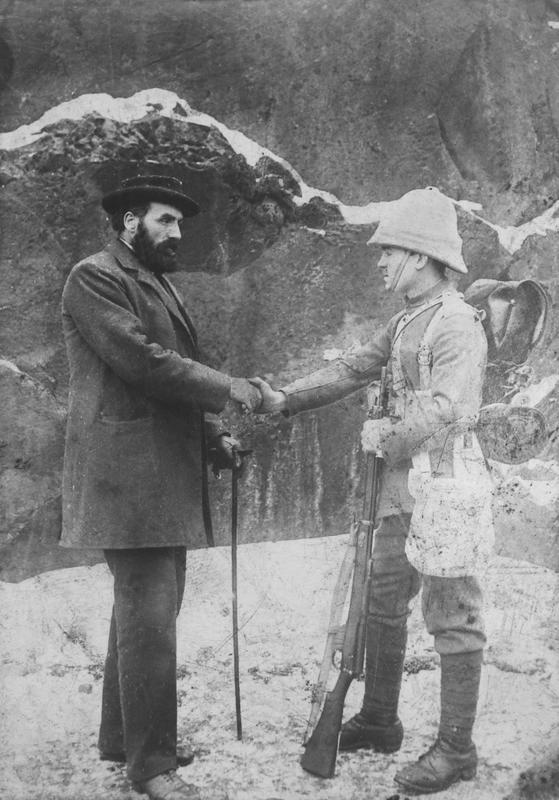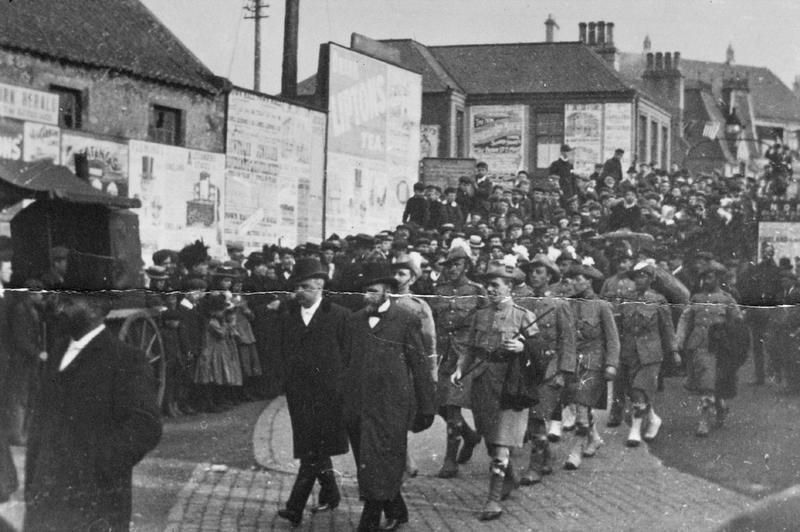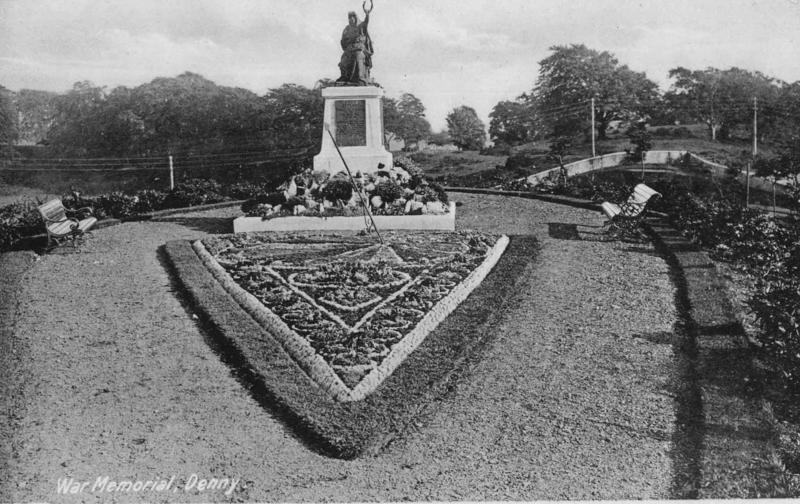Find out about how Falkirk rallied to support the families of those on the front during the Boer War.
The Strength
The Boer War memorial on Newmarket Street, Falkirk, commemorates the Second Anglo-Boer War that took place between October 1899 and May 1902. The war memorial depicts “a kilted infantryman in a slouch hat, defending a wounded comrade” (Ronald ‘Part 1’ p. 15). Underneath the statue, the monument presents a commemoration plaque that includes the names of the men from Falkirk and its districts that perished in the war. The history of the Boer War, the war between Dutch settlers, also called Boers, and the British, is well researched. For instance, Allan H. Ronald’s series of articles on “Bairns and Boers,” published in the 2013 issues of Calatria, the Falkirk Local History Society journal, gives a detailed account of the war and its links to Falkirk. The monument, however, does not commemorate the lesser known history and experiences of the wives and families left behind in Falkirk and the surrounding area during the Boer War.
Fundraising
The Boer War launched an unprecedented volunteering “movement to raise funds for the dependents of the reservists [and soldiers] at the front” at the beginning of the war, as Ronald states (“Part 1” p.18). The support of families of the reservists and soldiers fighting in the war was necessary as the British Government did not provide sufficient funds to support the reservists’ and soldiers’ families. At the time, soldiers had to ask the army for permission to marry. This permission was only granted to a few soldiers. The women of the soldiers with leave to marry were called “on the strength.” However, many soldiers also married without leave and their wives were called “off the strength.” Eliza Riedi points out in “Assisting Mrs Tommy Atkins” (2017) that ‘the army treated men married without leave as single and officially ignored their wives and families” (p.748). The army only provided limited support to women “on the strength” while ignoring women “off the strength.” However, even the support for women “on the strength” was insufficient, as Riedi explains:
“This did not cover full living costs, nor was it intended to: soldiers’ wives were expected to work. Military pay was so low that even “on the strength” wives living in barracks needed paid employment (normally washing for the regiment) to supplement the family income. For “off the strength” wives, waged work was vital; in illness and unemployment their families were abandoned to the mercies of the poor law” (Riedi p.749).
Solidarity
Charities and volunteering organizations stepped in to support the dependants of soldiers and reservists across the UK, including in Falkirk and its districts. Although people might have had different views on the war, many people agreed upon supporting the dependents of the soldiers and reservists sent to South Africa, which included not only wives and children but also aged parents. Riedi notes:
Support for soldiers’ dependants was strikingly cross-class. Many large firms [charity organizations such as the Soldiers’ and Sailors’ Families Association (SSFA)] subsidized by making weekly payments to the families of their reservist employees. Working-class mutuality, the “charity of the poor to the poor,” was equally significant (Riedi p.762).
fields['text']) echo $section->fields['text']; ?>
For instance, the Falkirk Herald reports on 11 November 1899, at the beginning of the Boer War, that in Grangemouth:
"A meeting of the employees of the Dockyard Company was held on Saturday morning at the breakfast hour, when it was unanimously agreed to ask the firm to deduct one penny per week off the wages of all employees for the support of wives and dependents of reserve men who reside or were working in the town, and who have been called up to serve their regiments, the said deductions to continue until they return to civil life, and that if any of them be killed or disabled a special levy to be made for such cases. The amount of weekly contributions will be between £5 and £6. A committee, consisting of James Buckie, caulker; Allan Bruce, blacksmith; Chas. Graham, joiner; James Campbell, carpenter; James C. Grassom, iron storekeeper, along with Mr Jackson, cashier, were appointed to distribute the fund, and they will be glad to hear of any dependents of reserve men in the town" (p.5).
The article demonstrates the exemplary support of working-class men for their fellow workers fighting in the war. Companies thus established their individual funds.


The War Fund
In addition, the Falkirk Herald also launched a War fund “for the relief of the wives and children of Falkirk and district reservists” (11 November 1899 p.5). The Falkirk Herald regularly published the amount collected and the names of the donators as well as the sums of each individual donation. On 9 December 1899, the Falkirk Herald Fund lists as donators, for instance, employees from several companies, such as the Falkirk Herald, the Laurieston Iron Company, the Carron Company, as well as staff and pupils from schools, such as the Grange School, and many individuals (p.3). Opinions regarding the war might have differed but support for the wives and children was unanimous. Donating or subscribing to the fund was made very easy as subscription sheets were readily available. The Falkirk Herald notes at the end of the donators’ list: “For the convenience of the Public, Subscription Sheets have been placed in the Banks and Post Office in Falkirk, in the Banks in Grangemouth, Larbert, and Camelon, as well as in most of the Public Works and other prominent places of business in Falkirk and District” (11 November 1899 p.5). In addition to subscriptions, the fund received money from further donations, for instance, the revenues of a concert organized “in aid of the wives and families of the local and district reservists called to the Transvaal War” on 9 December 1899 (Falkirk Herald p.3).
The Home Front
The local support of soldiers’ and reservists’ as well as the creation of funds in individual districts and companies demonstrate that the Boer War took not only place on the international level but was also experienced on the local level at home (Ried p.763). The war might have taken place in South Africa but its effects were felt in Scotland, in each household where a man had been sent to the war.
We would like to thank Russ Edwards, Great Place volunteer on Hidden Heritage Online: Statues and Monuments, for his help with this story.
By Alexandra Abletshauser, Hidden Heritage Online: Statues and Monuments volunteer 2020.

